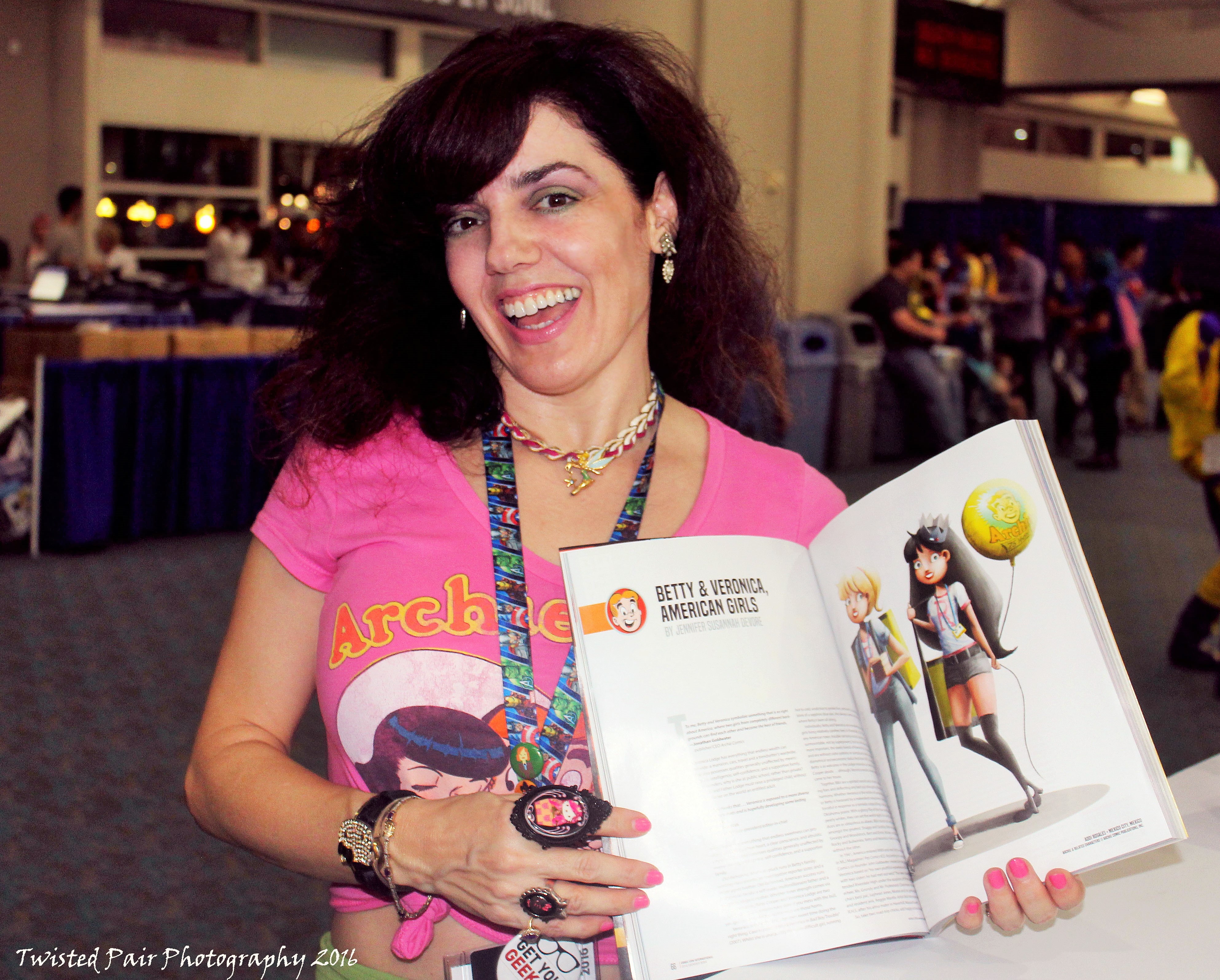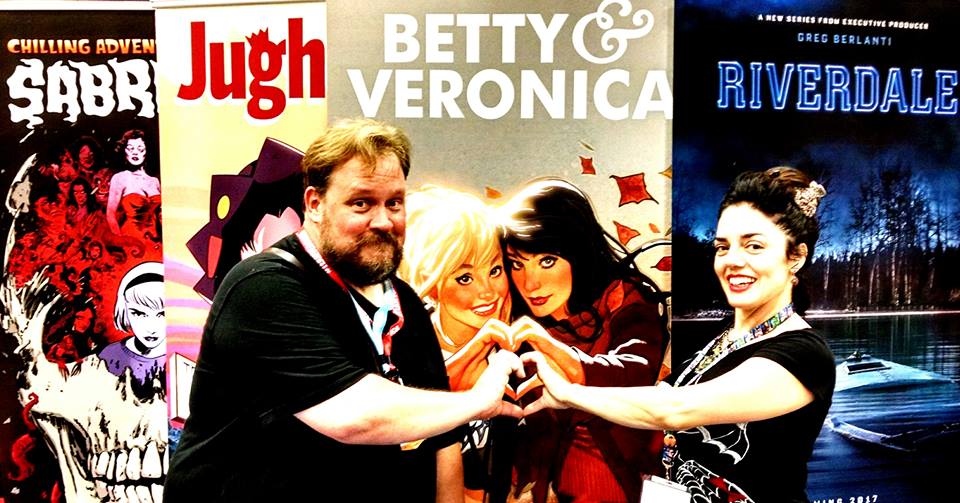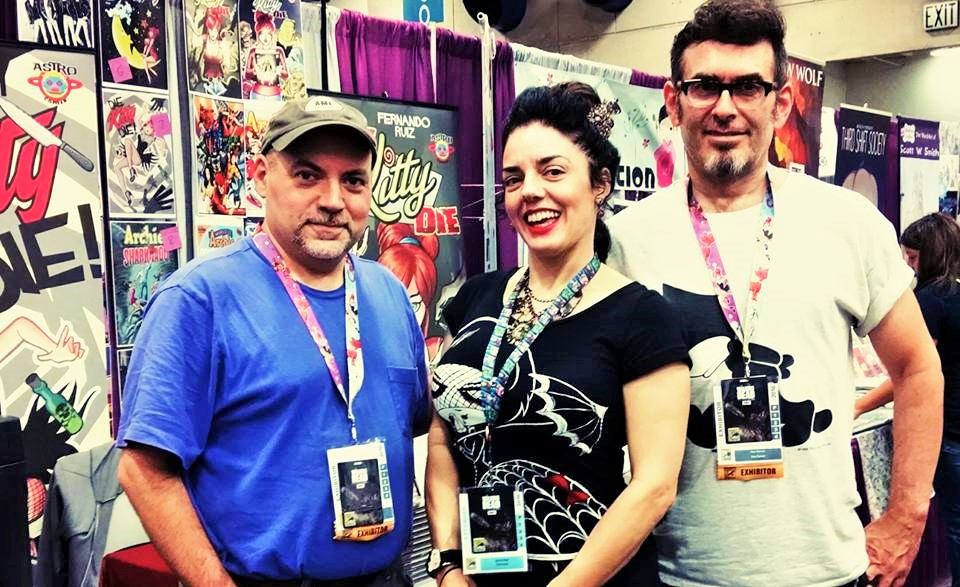Old-fashioned, American pluck runs in Betty's family: working-class parents, an investigative-reporter sister, and a secret-agent brother. Old-fashioned, American success runs in Veronica's family: a self-made, multimillionaire father and a generous, elegant mother. Whether inner strength comes via nurture or nature, Betty Cooper and Veronica Lodge are two girls not to cross. American rules state if you mess with the bull, you get the horns. Betty and Veronica are those horns.
Veronica, admittedly, takes her own sweet time doing the right thing: case in point, Betty & Veronica in Bad Boy Trouble (2007). Whilst she is unarguably the more difficult girl, running hot to cold, vindictive to protective, petulant to pleasing in the blink of a sapphire-blue eye, she always comes around, right to where Betty's been all along.
Individually, Betty and Veronica are enviable high school girls living, relatively, carefree lives in Riverdale, U.S.A.. Like any American town, trouble certainly exists; but here, it's surmountable, not by superpowers, but by self-assurance and, more importantly, the steely bonds of friendship. In a country and era without caste-systems or sumptuary laws, two girls of diametrical socioeconomic status find their BFF in each other. Betty is as welcome in the Lodge mansion as Veronica is in the Cooper abode … although, Veronica would always rather Betty came to her house.
Together, B&V are a spirited sword-and-shield vanquishing foes and deflecting any bad juju disrupting Riverdale's harmony. Whether Veronica is the victim of sartorial espionage or Betty is harassed by a malevolent newcomer, they are as forceful in response as a tornado catapulting cows across an Oklahoma prairie. With a glossy flip of the hair and pearly whites, they can set the world right. In comics, where duos are as ubiquitous as aliases, B&V stand tall and curvy amongst the greatest. Shaggy and Scooby, Batman and Robin, Snoopy and Woodstock, Ernie and Bert, Mickey and Minnie, Rocky and Bullwinkle, Betty and Veronica. Hard to imagine one without the other.
In 1941, America entered WWII, and met Archie and his girls in MLJ Magazines' Pep Comics #22. Archie Comics co-founder John Goldwater created Archie, Betty and Veronica, based on “his own youthful experience of an evening with two sisters he had met out west”. The new characters attended Riverdale High under the auspices of Principal Weatherbee, Ms. Grundy and Mr. Flutesnoot. Classmates included Archie's best pal, Jughead Jones, Moose and his girlfriend Midge, and resident jerk, Reggie Mantle. Artist Bob Montana modeled R.H.S. after his alma mater in Haverhill, Massachusetts.
So, take two road-trip chicks, add happy school-days in New England and Archie is as American as summers on Cape Cod, tearful admission prices at Disneyland, Hallowe'en in Salem and a Starbucks addiction.
First introduced under MLJ Magazines - named for founders Maurice Coyne, Louis Silberkleit and John Goldwater - Archie Andrews proved affable enough to merit his own title: Archie #1 (November 1942). Archie stood center-stage, yet it was gorgeous tomboy Betty Cooper and vivacious jet-setter Veronica Lodge whom stole the show.
Archie may have put the company of the map … but for me it's always been about Betty and Veronica. Archie is the steak, Ronnie and Betts are the sizzle.
- Craig Yoe, cartoonist
Like many septuagenarians, B&V have evolved, mostly. The 1940s/1950s pitted Ronnie and Betts as harsh rivals. Vicious, shifty antics were de rigueur to win the heart of dopey Archie, happily out of his league, or really any male. Betty and Veronica #27 (July/August 1947) proffers multiple catfights over a lifeguard, a nerd with a speed boat, and a pair of nylons. Through mid-Century, they spar over Archie, pulling him in opposite directions, sometimes literally, and team up only when Archie's affections fall on another girl. Even in the '90s they launch a bikini-battle for beach business. In Wiener Wars, Betty and Veronica Spectacular #5 (1993) the girls learn sex sells.
Come and get your all American hot dogs, boys!
- Betty, in stars-and-stripes bikini
However, starting with Betty and Veronica #179 (1970), B&V began earnestly contemplating social responsibility. The cover shows more message than midriff as the girls paint protest signs. Archie began highlighting women's liberation, civil rights and ecology, all while keeping B&V sassy and stylish. That style is a timeline of American fashion-zeitgeist.
It started in the 1940s with Old Hollywood couture. Marlene Dietrich and Jane Russell could have modeled for the chiseled jaws, tiny waists and shoulder pads drawn by Archie artists Bill Vigoda, Al Fagaly, Irv Novick and Samm Schwartz.
By the 1950s/1960s, a bouncier Betty and Veronica took shape under Bob Montana. In concert with fellow artists George Frese and Harry Lucey, the girls softened considerably after the 1940s hard-dame look. The post-War curves were softer, but all the more intense, perhaps because Harry Lucey drew the girls nude. (Note: B&V were drawn nude; Lucey did not draw in the nude. Ha!) Like Disney artists studying fawns and rabbits to best mimic nature, Lucey's method produced more natural looking figures, not to mention a treat for inkers. Betty became more Marilyn Monroe, Veronica more Bettie Page.
As the 1960s progressed, so did Archie's art department, adding Dan DeCarlo. Today, if you need to pick B&V out of police lineup, you'll point out the DeCarlo Girls. Under his pen, they became the iconic, comic book characters most recognized: less Hollywood glam, more TV animation, the medium most identifiable with '60s readers. Veronica was still a bombshell, but better suited to pizza at Pop Tate's, rather than descending the spiral staircase in Sunset Blvd. Betty was still a stunner, but better suited to her part-time gig at the garage, rather than enticing libidinous Nazis for bombing codes.
DeCarlo introduced us to all-American girls whom could live next door, depending on your neighborhood. They were, after all, high school girls, not forty-year-old leading ladies. DeCarlo drew the lion's share in the '60s/'70s; but the visions of Dan Parent, Al Hartley, Fernando Ruiz and Jeff Schulz escorted them all the way into the 2000s with verve and attitude.
As with Dietrich and Russell in the '40s, Jennie Garth and Yasmine Bleeth could have served as B&V models through the bubble gum '80s/'90s: approachable, California beach beauties. By the hipper mid-'90s, Sarah Michelle Gellar and Rose McGowan could have served: pretty faces and Pacific Northwest funk via artists Dan Parent and Fernando Ruiz.
In the 21stC., Betty and Veronica are their own women, no longer props or prizes for Archie. Maybe they learned self-value from Hermione Granger, Agent Carter, Taylor Swift and 2 Broke Girls. They still compete for Archie, but won't catfight over him today, shredding their clothes as in A Ripping Good Time, Betty and Veronica #158 (1969) … wait, 2 Broke Girls would totally catfight.
In 2015, Archie Comics published “New Look” Archie #1, with a new writer: Mark Waid (Daredevil). Waid has the Herculean task of simultaneously keeping B&V contemporary and historic. A 2015 interview with Comic Book Resources unearthed Waid's reverence for Archie.
... to approach long-standing franchises with enough respect for its history … it's a huge responsibility … but that makes it sound like grim drudgework, and this is wholly the opposite. This is a blast.
- Mark Waid, Archie Comics
2016 presents Waid with vastly different social cues than those for former writers like Bob Bolling, George Gladir and Kathleen Webb. Regardless of era, Ronnie and Betts' tale remains, simply, enduring friendship … and cuteness.
That cuteness is now in the hands of artists Fiona Staples (Saga) and Annie Wu (Hawkeye). Realistic with a digital hue, “New Look” B&V are more human than cartoon. “Traditional Look” titles are still published, but as Archie Digests. However they are drawn, new or traditional, sporting debutante gowns or jeans and baby-tees, Betty and Veronica are an American standard.
On Archie's 75th, in a culture that calls foul with the swiftness of Jughead on a plate of burgers, Archie has one mission: treat our American girls with respect … and keep them cute.

Contributor bio: Jennifer Susannah Devore lives at the beach, loves Disneyland, watches too much Netflix and is currently prowling the con-floor buying anything Hello Kitty. She authors the 18thC. historical-fiction series Savannah of Williamsburg, the contemporary-fiction The Darlings of Orange County and covers WC/SDCC for GoodToBeAGeek with her BFF Betty.
*A reprint from the Official 2016 Comic-Con Int'l Souvenir Book, editor Gary Sassaman*


Read all my SDCC Souvenir Book articles here!
Follow @JennyPopCom Twitter and Insta
JennyPop's Amazon Author Page, to boot!




